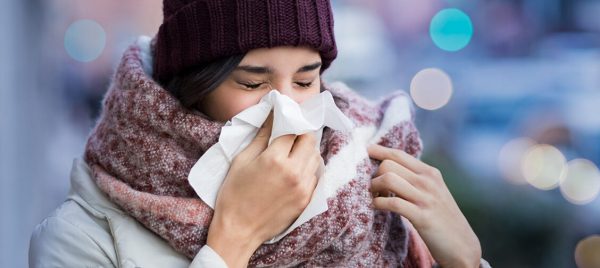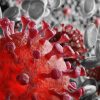 The fight against coronavirus has radically changed the way of life around the world. This could not but affect other living systems. In 2020, the viruses of influenza and other colds seem to have completely disappeared from the planet. However, as some countries lift restrictions, the viruses are returning, and they threaten to do so on an unprecedented scale and with consequences that can hardly be predicted. Irina Yakutenko, a molecular biologist and a scientific journalist, speaks on whether serious epidemics of influenza and other respiratory viruses await us in the near future.
The fight against coronavirus has radically changed the way of life around the world. This could not but affect other living systems. In 2020, the viruses of influenza and other colds seem to have completely disappeared from the planet. However, as some countries lift restrictions, the viruses are returning, and they threaten to do so on an unprecedented scale and with consequences that can hardly be predicted. Irina Yakutenko, a molecular biologist and a scientific journalist, speaks on whether serious epidemics of influenza and other respiratory viruses await us in the near future.
How Do Children Have Colds?
Respiratory Syncytial Virus (RSV) causes colds in humans. Each of us has repeatedly met with it, but since it was not customary to diagnose respiratory infections in the former USSR, RSV, like, say, coronaviruses, were held under the general code names of ARVI and ARI.
Children usually become infected with RSV in the first months of their life, and nearly everyone has antibodies to this virus by the age of two. For most infants, acquaintance with RSV is not dangerous, but in children with various immunodeficiencies, problems with the heart or respiratory system, as well as in those born prematurely, this virus can cause bronchitis and pneumonia.
In the case of premature babies, the reason for the more severe course is not only an immature immune system (it does not reach maturity in all babies), but also the lack of a sufficient amount of maternal antibodies against RSV.
As with other respiratory diseases, immunity to RSV diminishes rapidly, and people can re-contract it after a few months. But re-infections tend to be milder, apparently due to persisting antibodies and T cells. So the first encounter with RSV is most unpleasant, especially if a child does not have additional maternal antibody support.
ARVI Outbreaks After the Removal of Restrictions
Typically, an increase in the incidence of RSV is observed in winter. For example, in Germany, the season of this virus falls on November-April. In other months, only isolated cases are detected.
In the first half of 2020, there was no significant difference in the dynamics of RSV and influenza in the northern hemisphere. Restrictive measures in most countries began to be introduced after the cold season began to decline.
But Australia closed borders, obliged people to limit contact, introduced mandatory wearing of masks, home schooling and remote work just in the middle of spring, when the cold season begins in the southern hemisphere. But unexpectedly, it never appeared in 2020. As Australian epidemiologists found out, the number of influenza infections fell by 99.4%, RSV – by 98%.
Considering that during the pandemic, doctors tested patients with respiratory symptoms much more often than in previous years, this decrease cannot be explained by the insufficient volume of analyzes – there were just noticeably more analyzes than usual. The obvious reason for the disappearance of influenza and RSV is general quarantines, masks and a ban on mass gatherings and unnecessary contacts, in general.
The example of geographically isolated Australia clearly showed that these measures work perfectly not only against SARS-CoV-2, but also against respiratory viruses in general. By September 2020, there were no intra-community transmissions of the coronavirus in the country, so the measures began to gradually loosen up. And then the most interesting thing occurred.
Since the end of September – that is, in the middle of the Australian spring – there has been a sharp increase in the number of RSV cases on the mainland. Another article, published by Australian epidemiologists, provided data on RSV up to the end of December – and the number of reported cases had already exceeded the usual peak of RSV, which in Australia occurs in mid-July, and there is no sign of slowing down.
Moreover, another parameter of RSV epidemics has radically changed. It is the age of the sick. Usually, the bulk of patients who come to the attention of doctors because of the virus are babies from 7 to 12.5 months. In 2020, the average age of children with detected RSV turned out to be much higher – 18.4 months.
Why Will We Catch ARVI More Often?
In 2020, the human respiratory syncytial virus did not just change the seasonality: the entire dynamics of the epidemic turned out to be completely different. Because the patterns of attack of viruses on people are determined not only by the nature of pathogens, but mainly by the behavior of the people themselves.
Due to restrictive measures, the inhabitants of the planet behaved radically differently than in ordinary years. For example, in almost all regions of temperate latitudes, the seasonal cyclicality in the time that people spend indoors and outdoors has disappeared. Usually, during the colder months, residents of these countries spend most of the day inside buildings, often with poor ventilation and a large number of other people. It is with this circumstance, and not with some mysterious biological regularities, that the increase in the number of respiratory infections in winter and autumn is mainly associated.
During the pandemic, adults did not go to offices, did not travel on public transport, did not sit in cafes and restaurants, and children did not go to schools and kindergartens. As a result, no chains of transmission have emerged, using which respiratory viruses jump from one non-immune person to another.
The explosive increase in the number of new cases after the relaxation of restrictions and the higher peak are probably associated with the loss of those herd immunity residues that are always present in ordinary years. Immune protection after respiratory infections is short-lived, but it still works for several months – and, as the statistics of 2020 show, it is thanks to this protection that the peak number of cases does not exceed a certain established value.
This year, unexpectedly many people have lost their immunity, and now the virus is catching up.
The sharp rise is likely to continue until some new equilibrium is established.
The age shift is also explained by the changed behavior: usually babies get RSV from parents or siblings who bring the virus from “outside”. In 2020, family members communicated mainly with each other, and there were no intrusions of the pathogen from the outside.
Theoretically, acquaintance with RSV at a later age should have rather positive consequences: the older the child is, the higher his chances are of surviving the disease safely. Australian data indirectly supports this conclusion: so far, the percentage of children with RSV who require hospitalization does not exceed the usual values.
On the other hand, the older the child is, the higher the likelihood that he is receiving less breast milk, which means that there are fewer maternal antibodies, including those against RSV. So we should be more careful with long-term forecasts, especially since in the complex history of the relationship between people and viruses, there have been examples when some effect that improves the situation with some diseases significantly worsened it with others.
How Washing Hands Caused the Polio Epidemic

Poliomyelitis epidemic, 1916
In the 19th century, the world realized the power of hygiene: thanks to washing hands, dividing into clean and dirty areas in the kitchen, processing food, the number of intestinal diseases fell sharply, and with them infant mortality. But at the same time, the number of children who developed severe paralysis began to increase significantly – and in developed countries this attack was encountered much more often than in developing countries.
The nature of the mysterious disease was established at the beginning of the 20th century: children were crippled and often killed by poliovirus, the pathogen that causes poliomyelitis. It coexisted with people for many centuries, but before the habit of necessarily washing hands appeared, the vast majority of babies got acquainted with poliovirus even at the breastfeeding stage, when a large amount of maternal antibodies were present in their blood. They partially neutralized the virus, allowing the baby to develop its own antibodies, but preventing a severe course of the disease.
Thanks to the fact that mothers began to observe hygiene measures, the first encounter of children with the polio virus was postponed to a later date, when the antibodies they had inherited from their mother were already destroyed.
The result is monstrous waves of polio around the world, which have claimed the lives of tens of thousands of children and crippled millions. The disease was brought under control only in the 1950s and 1960s, thanks to universal vaccination.
Should We Expect a Flu Outbreak?
It is difficult to predict what the long-term results of the change in the relationship between humans and the respiratory syncytial virus will be. But they probably shouldn’t be too hard, as the disease it causes usually goes away easily.
But the balance in the interaction between Homo sapiens and influenza, disturbed by quarantine measures, can lead to more serious consequences.
With the dramatic decline in influenza infections in 2020–2021, it will be difficult for influenza vaccine scientists to predict which strain will predominantly spread across the planet in the coming seasons. Usually, experts decide which strain to create a vaccine for based on data on the incidence of influenza in the non-epidemic months. If there are no or almost no such cases, it is difficult to calculate which virus will be the main one in the upcoming epidemic.
At the same time, due to a long break in meetings with the pathogen, humanity will lose its partial collective immunity against influenza, which mitigates outbreaks.
So it is possible that the first flu season after the anti-coronavirus restrictive measures are more or less lifted may turn out to be very harsh: due to the loss of individual immunity and collective protection, more people will get sick than usual, plus there is a high probability that scientists will not guess the dominant strain in the vaccine. And all this, perhaps against the backdrop of fewer hospital beds, if coronavirus restrictions are lifted before enough people are vaccinated to form herd immunity to covid.
These gloomy prospects are not a reason to abandon masks and distance ahead of time, or even more so to believe that such restrictions were unnecessary. The lethality of SARS-CoV-2 is much higher than that of influenza, and by slowing its spread with restrictive measures, we have saved hundreds of thousands of lives.
However, such an active intervention in the established relationship between people and viruses could not pass without a trace, and the likely severe flu season is the price to pay for the imbalance.
To prevent such troubles in the future, it is necessary to debug the monitoring system for potentially dangerous viruses and their natural reservoirs. And also radically revise the school curriculum, increasing in it the number and method of presenting information about the basic foundations of health and general biological principles of the work of living organisms and systems.

















